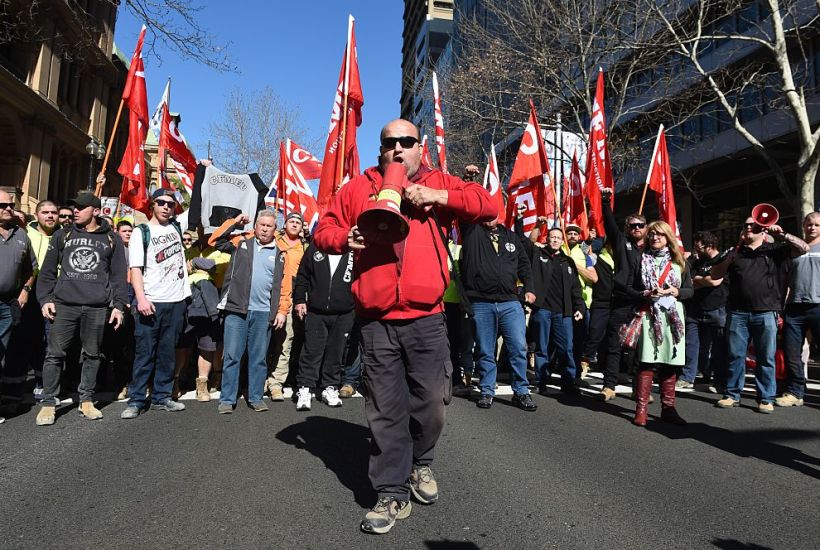It seems the lines have been drawn for 2018 as Sally McManus and the ACTU declare there is a war against the unions “right to strike”. The seeds were planted early this year after the Fair Work Commission halted a New South Wales rail strike that was voted for by only six per cent of the union’s rail workers via a text poll. With such small numbers, one would question if the whole thing was planned or staged to begin with, much the way “Ferry McFerryface” one per cent voter approval came to light.
Even with a small six per cent yes vote and a 94 per cent uninterested or no vote, the unions declared the strike was on, setting up the showdown culminating in the unions’ declaration their “right to strike” was being destroyed.
But what about the rights of the 94 per cent? This would only seem fair for the huge portion of rail workers who saw no desire to strike to have a right to, well, not strike.
Other than cases where force was used, unions originally promoted the majority will of their members collectively joined together leveraging their talent and skills to request better working conditions or benefits. Unless thug tactics were used, those in the group all had a unified issue to correct.
What Australia has today are a few large politically oriented unions designed to advance political points where the ends justifies the means, not the needs of their members.
Key to the problem built into the ACTU’s argument is their interchangeable use of the terms “right to strike” and the “right to withdraw one’s labour,” as if the two are compatible.
To clear up any newspeak, the “right to withdraw one’s labour” can be a fundamental natural right. You have a right to quit, leave, or do whatever free of coercion but not without consequences. It is another way to say, “You have a right to yourself only”. Any real “right” is condensable down to this and if not, then it is impinging on another person rights, and therefore is no right.
The “right to strike” operates not as a true right, but as a political tool, attempting to eliminate any negative consequences for the strikers while trampling upon the rights of employers and other coworkers.
Positive and negative consequences together are crucial signals to determine whether individual’s actions are beneficial in the marketplace. By eliminating employees’ risks in a strike, demands can be limitless and push towards the absurd. Meeting absurd demands would prove detrimental to a business, although even if the absurd demands are not met these actions are poor signals for future entrepreneurs.
Negative long-term signals begin to slow growth as fewer entrepreneurs take the risk of opening businesses, wealth begins to leave as companies open factories elsewhere, all while the youth, elderly, poor and minority classes are hit hardest with fewer opportunities.
Eliminating negative effects on employees comes at the loss to other groups’ rights such as the business owners and fellow employees. Entrepreneurs build up sizeable saving through their own labour to create a company that provides value in the marketplace. If a “right to strike” exists the business owner is held hostage forced to wait it out. The entrepreneur is forced to give up their right to property and is involuntarily required to retain the striking employees giving up the freedom of association.
The other group’s rights trampled upon are the striker’s fellow employees who have no desire to do so. Do they not have a right to strike the strike?
An employee forced to join a strike that is harmful to their life is, in a sense, a form of slavery. Employees and union member should have their right to themselves protected, a right to withdraw their labour as they see fit, even if from a strike.
Upholding the individual’s right to oneself, and freeing Australia from this politically charged idea of a “right to strike” will gradually start improving Australians lives. For instance, small-scale entrepreneurs see lower costs of entry into union-dominated industries lowering costs on consumers.
Employee benefits can be directly tied to individual needs rather than determined by the collective. Benefits will coalesce around value created rather than uniformly distributed regardless.
Union existence could once again be tied to offering value to their members, rather than politicly charged motivations. Group action for workplace improvement can be done so by responsibly leveraging skills with realistic expectations.
As these battle cries are made by unions, we need to ask how these ideas would help the most in need. We must realize these ends are not justified by means the ends are dictated by the means used.
Greg Pulscher is executive director of the H.R. Nicholls Society.
Got something to add? Join the discussion and comment below.
Got something to add? Join the discussion and comment below.
Get 10 issues for just $10
Subscribe to The Spectator Australia today for the next 10 magazine issues, plus full online access, for just $10.


























Comments
Don't miss out
Join the conversation with other Spectator Australia readers. Subscribe to leave a comment.
SUBSCRIBEAlready a subscriber? Log in